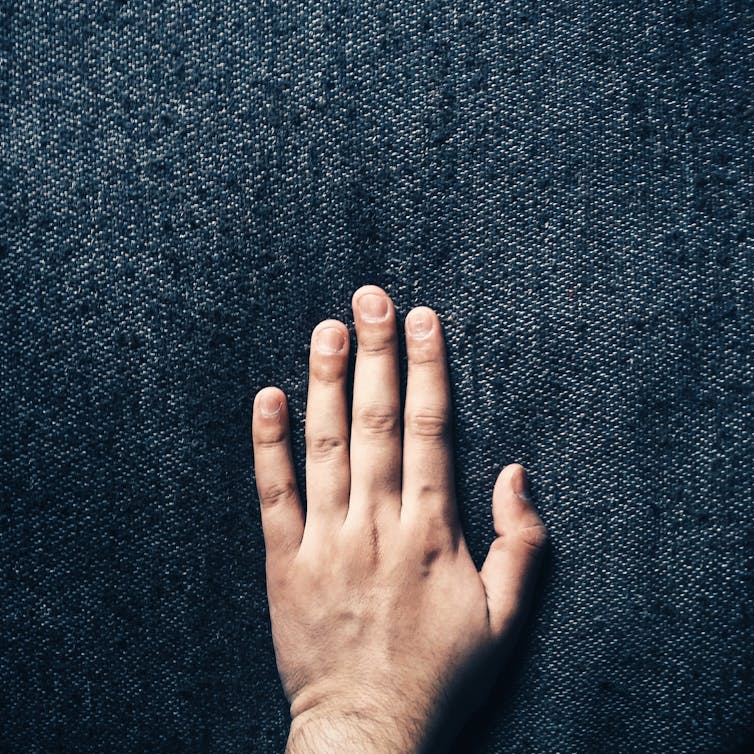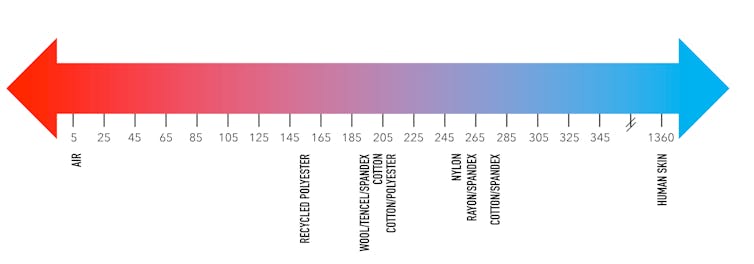Cool touch shirts can make you feel cool on hot days, but which materials work best?
- Written by Susan L. Sokolowski, Director & Associate Professor of Sports Product Design, University of Oregon
It’s another hot and sweaty summer day, and you see an ad for a sports T-shirt claiming it is made out of a material that will instantly make your skin feel cool. Intriguing, but does it work, and if so, how?
Companies have embraced what are called cool touch materials[1] for all sorts of products. Bed sheets that will ease hot flashes, facial tissues that will calm a sore nose, or a business suit that will keep you comfortable during a tough interview - these are just some ways companies have turned to cool touch technologies.
I am a professor of sports product design[2] and my research looks at how apparel materials can help keep athletes cooler in hot environments[3]. Staying cool is important because it can affect performance psychologically and physiologically and cool touch materials are one way designers like me can enhance performance.
 Thermal effusivity can measure how any material – a fabric, a rock or air – feels to the human touch.
Madhav Gajjar/EyeEm via Getty Images[4]
Thermal effusivity can measure how any material – a fabric, a rock or air – feels to the human touch.
Madhav Gajjar/EyeEm via Getty Images[4]
Measuring material heat transfer
Effusivity is a heat transfer property present in all materials[5] that incorporates the thermal conductivity, density and heat capacity of a material. Thermal effusivity describes how fast and how much heat can be transferred from one material to another. If you touch something that has high effusivity, the transfer of heat from your skin into the material produces the sensation of coolness
The higher the thermal effusivity value a material has, the cooler it will feel to the touch. The lower that value, the warmer a material will feel. For example, air has an effusivity value of 6, natural rubber is 518, human skin is 1360 and silver is 23688[6]. Even when a piece of natural rubber and silver are the same room temperature, the silver will still feel colder because it has a higher effusivity value.
On a winter morning, differences in thermal effusivity are what make stepping onto a cold hardwood floor with your bare feet so much less comfortable compared to when you’re wearing wool slippers. This happens because the wood has a higher effusivity value, so it feels much colder. On the other hand, if you got out of bed and put on some woolly slippers - your bare feet and slippers have effusivity values that are closer together, therefore your toes will feel super cozy.
This same principle can apply to athletic T-shirts. My colleagues and I wanted to identify materials that have high effusivity values so that the next time you are getting ready for a pick-up game of basketball in the grueling heat, you could choose a T-shirt that will give you a cool feeling next to your skin.
It’s in the material
So, what T-shirt material provides athletes the best cool touch feel?
To get to the bottom of this question, our research team collected effusivity data from seven sport T-shirt materials made of polyester, recycled polyester, rayon, wool, nylon, cotton and spandex fibers. To keep the competition fair, we made sure all of the fabrics were made the same way – with a common jersey knit[7] construction.
 The face (left) and back (right) sides of a jersey knit material have different effusivity properties.
Jeremy Stangeland, CC BY-ND[8]
The face (left) and back (right) sides of a jersey knit material have different effusivity properties.
Jeremy Stangeland, CC BY-ND[8]
Jersey knits have distinct face and back side aesthetics. The face side has vertical rows of knit stitches and is the outside of a T-shirt. The back side of a jersey knit has stitches assembled horizontally and is usually on the inside of a T-shirt.
[Deep knowledge, daily. Sign up for The Conversation’s newsletter[9].]
And the winner is…
If you are a connoisseur of sports apparel, you probably expected that a shirt made of 100% recycled polyester[10] fiber-based materials would have performed the best, and cotton ones the worst. But in our upcoming paper to be published, we found the exact opposite. Materials composed of recycled polyester fibers had the lowest effusivity and would therefore feel the warmest next to your skin on a hot day. The winner and the material with the highest effusivity in our study was a fabric made of 95% cotton and 5% spandex. If you want something to feel cool on your skin on a hot day, this is the best choice.
 The higher the thermal effusivity of a material, the cooler it feels to the touch.
Susan Sokolowski, CC BY-ND[11]
The higher the thermal effusivity of a material, the cooler it feels to the touch.
Susan Sokolowski, CC BY-ND[11]
But the types of fibers were not the only thing that affected effusivity. Our team found that the back side of the material that touches your skin had higher thermal effusivity than the face side. As most T-shirts are made from jersey knit materials, if you ever find yourself a bit chilly, simply turning your shirt inside out might help.
 In addition to the thermal effusivity, sweat management, airflow, reduction of cling and many other attributes go into making a piece of apparel that keeps you cool.
Krista Long/Moment via Getty Images[12]
In addition to the thermal effusivity, sweat management, airflow, reduction of cling and many other attributes go into making a piece of apparel that keeps you cool.
Krista Long/Moment via Getty Images[12]
Effusivity alone does not make a cool shirt
While the thermal effusivity of a material is one important design attribute for a cool T-shirt, it is not the only thing to consider.
Wicking[13] – the ability for a material to transport sweat from the skin to the environment to promote evaporation – is also incredibly important. As the sweat evaporates from the shirt’s material, it cools you down[14].
Air moving through a T-shirt material can also help cool you down, and that can be achieved with ventilation holes or mesh. Materials can also be engineered to be less clingy and insulative. Clingy shirts not only feel uncomfortable and sticky, they also reduce airflow and make you feel hotter. Materials that are too insulative just keep you warmer, and who needs that in hot weather?
Cool, high-tech T-shirts can be quite complex to design, but when the details are carefully considered and balanced, you can get a shirt that will make you feel cool through effusivity, wicking, ventilation and reduction of insulation and cling – and of course, probably the most important factor, make you look cool too.
References
- ^ cool touch materials (www.travelandleisure.com)
- ^ professor of sports product design (artdesign.uoregon.edu)
- ^ keep athletes cooler in hot environments (scholar.google.com)
- ^ Madhav Gajjar/EyeEm via Getty Images (www.gettyimages.com)
- ^ Effusivity is a heat transfer property present in all materials (ctherm.com)
- ^ silver is 23688 (thermalanalysislabs.com)
- ^ jersey knit (www.wisegeek.com)
- ^ CC BY-ND (creativecommons.org)
- ^ Sign up for The Conversation’s newsletter (theconversation.com)
- ^ 100% recycled polyester (www.palmgear.com)
- ^ CC BY-ND (creativecommons.org)
- ^ Krista Long/Moment via Getty Images (www.gettyimages.com)
- ^ Wicking (www.shirtspace.com)
- ^ cools you down (www.wired.com)
Authors: Susan L. Sokolowski, Director & Associate Professor of Sports Product Design, University of Oregon


